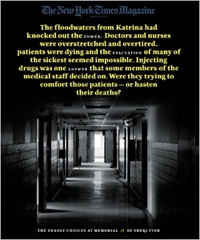 The cover story in this weekend’s New York Times Magazine is a 13,000-word investigation of the New Orleans hospital where patients were euthanized in the wake of Hurricane Katrina. It’s a remarkable and tragic story that may also represent the most expensive single piece of print journalism in years.
The cover story in this weekend’s New York Times Magazine is a 13,000-word investigation of the New Orleans hospital where patients were euthanized in the wake of Hurricane Katrina. It’s a remarkable and tragic story that may also represent the most expensive single piece of print journalism in years.
This is the new economics of news production: The reporter, Sheri Fink, began working on the project in 2007 as a fellow at the Kaiser Foundation and stayed on the story nearly full-time after joining ProPublica, the non-profit, investigative-journalism outfit, in 2008. Later that year, Fink and her editors began collaborating with the Times Magazine, which did not pay for the piece. It’s also available on ProPublica’s site, and anyone is free to republish the article in full beginning on September 29.
Gerald Marzorati, editor of the Times Magazine, caused a minor stir this week when he estimated that the article cost $400,000 to produce. That turns out to be an exaggeration, but the order of magnitude is correct.
Every once in a while we get a new datapoint about the cost of quality journalism. The relevance of those figures is debatable at a time when we’re rethinking the how of journalism as much as the what, but they’re good to know, and I’ve filed away a few. Among them: The New York Times’ Baghdad bureau costs $3 million a year, while The Washington Post’s drains $1 million; The Miami Herald’s audit of the 2000 presidential election results in Florida put the paper out $850,000; The St. Petersburg Times’ PolitiFact project has been estimated in the high six figures; and Marzorati has previously said that his average cover story runs “north of $40,000.”
In this case, Fink was paid $33,000 plus $10,000 in expenses for her Kaiser fellowship, according to Steve Engelberg, her editor at ProPublica, where she’s been for 14 months. Engelberg, who was kind enough to go through these figures with me, said, “Fourteen months of salary plus benefits for us easily gets you north of 100 plus, 100, 150 or something.” He threw in another $20,000 to $30,000 for travel expenses, in addition to three months of editing and lawyering at ProPublica and the Times, which also spent $25,000 to $30,000 on photographs, he said.
Grand total: a lot of money.
Marzorati told me his estimate of nearly $400,000 considered what the piece would have cost had it been produced entirely by Times staffers. He wrote in an email, “My point, really, is simply this: Investigative reporting is very, very expensive.” And no matter how you crunch the numbers, that’s certainly true.
These sorts of calculations inevitably lead to impossible cost-benefit analyses. It would be even more difficult this time: What was the actual cost to the Times? Does cost mean the same thing to nonprofits like Kaiser and ProPublica? And do you measure benefit in impact, pageviews, or what? (A Times memo this morning happened to note that last week’s cover story, an excerpt from Nicholas Kristof and Sheryl WuDunn’s new book on global oppression of women, topped a million pageviews.) There are no answers, and I’m just filing away this datapoint with the others.
UPDATE, 3:13 p.m.: Fink emailed me to note that, in addition to what I noted above, she spent four months in 2007 covering the story at her own expense. And in the comments, Stan Alcorn of the Dart Center points to their video interview with Fink. So you’ve got Kaiser, ProPublica, Dart, and Fink on her own as a freelancer — all contributing without compensation to the final product here. New economics, indeed.